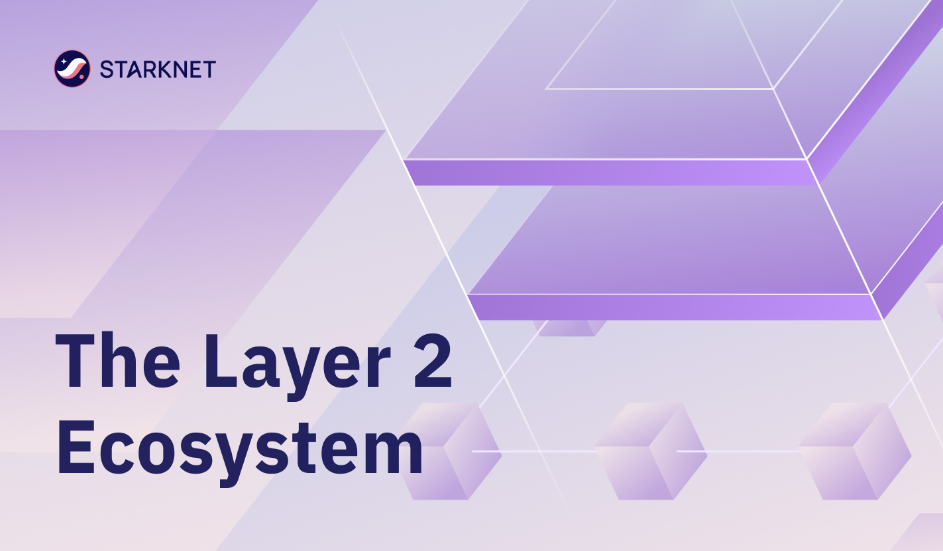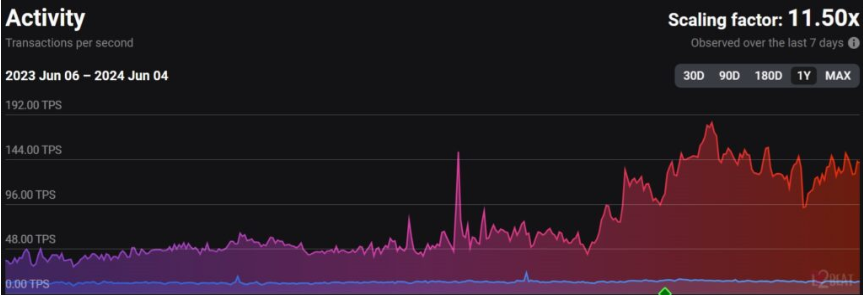The L2 ecosystem is developing rapidly, so what are the L2 technologies and mainstream projects? What are the challenges they face and the measures for improvement?
Author: Starknet
Translated by: Plain Blockchain

As blockchain technology continues to develop, Ethereum achieved a record of 2 million daily transactions in January 2024. However, the scalability issues between first-layer (L1) chains such as Bitcoin and Ethereum still limit their widespread adoption.
As a result, second-layer (L2) solutions have emerged: a series of technologies aimed at accelerating transactions and reducing costs without compromising the security and decentralization of leading L1 networks. According to L2Beat's data, L2 scaling solutions have already transformed Ethereum, handling transaction volumes 11-12 times that of Ethereum itself.

Source: L2beat.com
This article explores the L2 ecosystem, including its key innovations, challenges, and future development directions.
1. The Origin of L2
As more and more users transact on L1, these networks become slower and more expensive. Solving scalability issues on L1 often means compromising between security or decentralization, both of which are desired features for all blockchains. The compromise of choosing only two out of the three desired blockchain features of scalability, decentralization, and security is known as the "blockchain trilemma."
Solving the blockchain trilemma is particularly important for Ethereum, as it has become the preferred L1 for building decentralized applications (dApps). Among these three desired features, Ethereum has chosen security and decentralization at the expense of scalability.
To expand the use cases and types of Ethereum, it must be economically feasible to build more complex dApps.
L2 solutions have emerged as a way to address these issues by moving most of the heavy computation related to processing transactions from the base layer to the second layer, increasing transaction throughput, reducing costs, and improving user experience. The goal is to achieve this while leveraging the security and decentralization of the underlying L1 blockchain.
2. Core Technologies and Frameworks
The total value locked (TVL) in the L2 ecosystem has now exceeded $46 billion, encompassing various technologies and frameworks with unique characteristics. Let's take a closer look at some of the most important technologies:
Rollups - Rollups come in two types: Optimistic Rollup and Validity/Zero knowledge Rollup. Optimistic Rollups assume transactions are valid by default. They enable network participants to challenge transactions expected to be fraudulent by using "fraud proofs" to prove their invalidity, thus preventing fraud. In contrast, Validity Rollups use "validity proofs" to prove the validity of each transaction submitted to the base layer. These two types of rollups provide higher throughput and lower costs compared to L1.
State channels - State channels allow participants to conduct off-chain transactions by locking a portion of the blockchain state into a multi-signature contract. Participants can freely transact off-chain, with the final state settled on-chain. State channels offer near-real-time transactions and low costs but have limitations in functionality and the number of participants.
Plasma - Plasma is a framework for creating layered side chains anchored to the main chain. Plasma chains can process transactions off-chain and only submit periodic updates to the main chain, relieving the burden on the L1 network. Similar to Optimistic Rollups, Plasma chains use fraud proofs to challenge suspicious transactions.
3. Examining the L2 Ecosystem
The L2 ecosystem is rapidly evolving, with numerous projects and initiatives working to expand major L1 blockchains. While some solutions are dedicated to bringing scalability to Bitcoin, such as the well-known Lightning Network, which utilizes state channels to provide faster and cheaper transactions on the network, a general-purpose L2 solution has not yet emerged for Bitcoin.
On the other hand, Ethereum has nurtured a thriving L2 solution ecosystem. We will focus on the main participants and briefly describe them.
1) Validity Rollups (also known as Zero-Knowledge Rollups)
Starknet: A Validity Rollup with the fastest-growing developer community, featuring native account abstraction and its own programming language (Cairo), optimizing the ability to utilize validity proofs.
- zkSync: Another leading Validity Rollup with native account abstraction, running on the Ethereum Virtual Machine (EVM).
- Scroll: A Validity Rollup compatible with EVM, focusing on native compatibility with existing Ethereum dApps and tools.
- Polygon zkEVM: Developed by the L2 scaling veteran company Polygon, zkEVM is a Validity Rollup compatible with EVM.
- Linea: Supported by the company behind MetaMask, Consensys, Linea is a Validity Rollup that can be used directly through MetaMask.
2) Optimistic Rollups
- Arbitrum: Measured by Total Value Locked (TVL), it is the largest Optimistic Rollup, compatible with EVM.
- Optimism: Measured by TVL, it is the second-largest Optimistic Rollup, compatible with EVM.
- Base: Measured by TVL, it is the third-largest Optimistic Rollup, compatible with EVM.
Many of these projects are still in the early stages, often involving a period of centralized control called a "bootstrapping phase," allowing for controlled system updates and bug fixes. While initially necessary, these bootstrapping phases should eventually be removed to achieve the expected decentralization and trustless operation.
The adoption of L2 solutions is steadily growing in various fields, including decentralized finance (DeFi), non-fungible tokens (NFTs), and blockchain games. The most commonly used L2 types are often Optimistic Rollups and Validity Rollups. However, the integration of L2 solutions is not without challenges.
4. Challenges and Solutions
Although L2 solutions have tremendous potential, they still need to overcome some challenges to realize their full potential. From a user's perspective, interacting with L2 networks may be slightly more complex, requiring additional steps such as bridging assets and managing multiple wallets. Improving user experience through better wallet integration, simplifying onboarding processes, and providing more intuitive interfaces will be crucial for driving mainstream adoption.
This is why Starknet provides built-in account abstraction, enabling a smoother user experience, such as transaction signing through facial recognition and fingerprint recognition (for example, the Braavos wallet offers both features). On Starknet, expanding Ethereum means that a Web2-style user experience is just as important as cheaper and faster transactions.
5. Prospects for L2
As the L2 ecosystem matures, we can anticipate a wave of innovation, such as native account abstraction on Starknet. Hybrid solutions combining the advantages of different L2 technologies have begun to emerge, providing dual benefits for Optimistic Rollups and Validity Rollups. Advancements in validity proofs (such as STARKs) further enhance the scalability and privacy of L2 networks.
Looking ahead, the future of L2 solutions is closely tied to the overall development of blockchain technology. As L1 networks continue to evolve and new consensus mechanisms like proof of stake are promoted, L2 solutions will need to adapt and seamlessly integrate with these changes.
In the coming years, we will see the flourishing development of L2 solutions tailored for specific use cases and application domains. Some predict that L2 networks will eventually become the primary layer for user interactions, with L1 serving as a secure settlement layer. Others envision a multi-layered blockchain architecture, with L2 solutions evolving in parallel, sometimes with a third layer (L3) chain on top, to create a scalable and interoperable ecosystem.
6. Conclusion
As the L2 ecosystem continues to evolve, collaboration and contributions between developers, researchers, and users are crucial for developing powerful and user-friendly L2 solutions.
By embracing the potential of L2 technology, the blockchain community can overcome the limitations of L1 networks and unlock new possibilities for decentralized applications. The road ahead is filled with challenges and opportunities, but with the right approach and a shared vision, we can build a scalable and inclusive blockchain ecosystem, empowering individuals and transforming industries.
Original article link: https://www.hellobtc.com/kp/du/06/5246.html
Source: https://www.starknet.io/blog/layer-2-ecosystem/
免责声明:本文章仅代表作者个人观点,不代表本平台的立场和观点。本文章仅供信息分享,不构成对任何人的任何投资建议。用户与作者之间的任何争议,与本平台无关。如网页中刊载的文章或图片涉及侵权,请提供相关的权利证明和身份证明发送邮件到support@aicoin.com,本平台相关工作人员将会进行核查。



